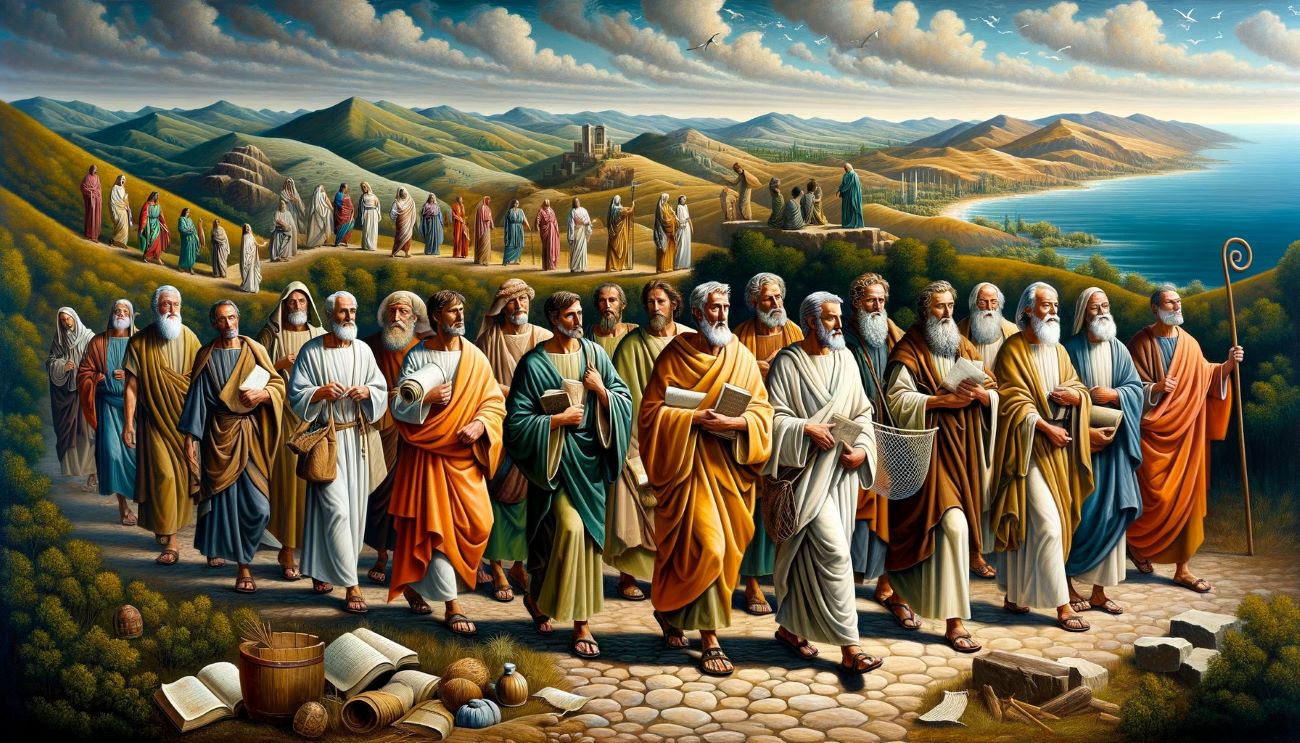Home>Christian Videos>Bible Stories>What Are The Differences Between The Four Gospels?


Bible Stories
What Are The Differences Between The Four Gospels?
Published: March 5, 2024
Jason DeRose, Managing Editor at Christian.net, uses his expertise in religion and journalism to deepen understanding of faith's societal impacts. His editorial leadership, coupled with a strong academic background, enriches the platform’s diverse content, earning him recognition in both journalism and religious circles.
Discover the unique perspectives of the four Gospels and gain insight into the diverse portrayals of the life and teachings of Jesus in the Bible stories. Explore the differences and similarities to deepen your understanding.
(Many of the links in this article redirect to a specific reviewed product. Your purchase of these products through affiliate links helps to generate commission for Christian.net, at no extra cost. Learn more)
Table of Contents
Introduction
What are the differences between the four Gospels? The Gospels of Matthew, Mark, Luke, and John are the first four books of the New Testament in the Christian Bible. Each Gospel presents a unique perspective on the life, teachings, death, and resurrection of Jesus Christ. While they share many similarities, there are also significant differences in their content, style, and theological emphasis. Understanding these differences can provide valuable insights into the diverse ways in which the early Christian communities interpreted and communicated the message of Jesus. Let's explore the distinct characteristics of each Gospel and the key differences between them.
The Gospel of Matthew
The Gospel of Matthew is traditionally attributed to Matthew, one of Jesus' twelve disciples. It is believed to have been written between 70 and 110 AD, making it one of the earliest accounts of Jesus' life. Matthew's Gospel is often characterized by its focus on presenting Jesus as the fulfillment of Old Testament prophecies, emphasizing his role as the long-awaited Messiah. The Gospel opens with a genealogy tracing Jesus' lineage back to King David, highlighting his royal heritage. Throughout the narrative, Matthew frequently references Old Testament scriptures to demonstrate how Jesus' life and ministry align with the prophetic writings. This Gospel also contains the Sermon on the Mount, a collection of Jesus' teachings that emphasize ethical and moral principles for his followers. Additionally, Matthew's Gospel places a strong emphasis on the concept of the kingdom of heaven, portraying Jesus as the rightful king and ruler. The Gospel of Matthew is structured to appeal to a Jewish audience, seeking to establish Jesus as the fulfillment of Jewish hopes and expectations.
- The Gospel of Matthew emphasizes Jesus as the fulfillment of Old Testament prophecies.
- It opens with a genealogy tracing Jesus' lineage back to King David.
- Matthew frequently references Old Testament scriptures throughout the narrative.
- It contains the Sermon on the Mount, a collection of Jesus' teachings on ethical and moral principles.
- The Gospel places a strong emphasis on the concept of the kingdom of heaven, portraying Jesus as the rightful king and ruler.
The Gospel of Mark
The Gospel of Mark is the shortest of the four Gospels and is traditionally attributed to John Mark, a companion of the apostle Peter. It is believed to have been written around 65-70 AD, making it one of the earliest accounts of Jesus' life. Mark's Gospel is characterized by its fast-paced and action-oriented narrative, focusing on the deeds and miracles of Jesus. Unlike Matthew and Luke, Mark does not include a birth narrative of Jesus, but rather begins with the ministry of John the Baptist and the baptism of Jesus. The Gospel of Mark portrays Jesus as a powerful and enigmatic figure, often using the term "Messiah" in a veiled manner, known as the Messianic Secret. Mark's emphasis on the suffering and humanity of Jesus is evident in his portrayal of the disciples' misunderstandings and Jesus' emotional experiences, such as his agony in the Garden of Gethsemane. The Gospel of Mark concludes with the resurrection of Jesus, leaving the readers with a sense of awe and wonder at the profound implications of this event.
- The Gospel of Mark is the shortest of the four Gospels.
- It is traditionally attributed to John Mark, a companion of the apostle Peter.
- Mark's Gospel is characterized by its fast-paced and action-oriented narrative.
- It focuses on the deeds and miracles of Jesus.
- Unlike Matthew and Luke, Mark does not include a birth narrative of Jesus.
- The Gospel portrays Jesus as a powerful and enigmatic figure, often using the term "Messiah" in a veiled manner.
- Mark's emphasis on the suffering and humanity of Jesus is evident in his portrayal of the disciples' misunderstandings and Jesus' emotional experiences.
- The Gospel of Mark concludes with the resurrection of Jesus, leaving the readers with a sense of awe and wonder at the profound implications of this event.
The Gospel of Luke
The Gospel of Luke, attributed to the physician and companion of the apostle Paul, is known for its meticulous attention to detail and its emphasis on compassion and inclusivity. Believed to have been written between 80 and 100 AD, Luke's Gospel begins with a prologue addressed to a man named Theophilus, expressing the author's intention to provide an orderly and accurate account of the life of Jesus. Luke's narrative includes unique stories not found in the other Gospels, such as the parables of the Good Samaritan and the Prodigal Son, which highlight the themes of mercy, forgiveness, and the inclusive nature of God's kingdom. The Gospel of Luke also features a strong focus on the role of women in Jesus' ministry, portraying them as active participants and witnesses to the unfolding of God's redemptive plan. Additionally, Luke's Gospel contains the most detailed account of Jesus' birth and early childhood, including the Annunciation, the Magnificat, and the Benedictus, which emphasize the divine significance of Jesus' coming. Luke's portrayal of Jesus as a compassionate savior who reaches out to the marginalized and the outcasts reflects his overarching theme of universal salvation and the fulfillment of God's promises to all people.
- The Gospel of Luke is known for its meticulous attention to detail and its emphasis on compassion and inclusivity.
- It begins with a prologue addressed to a man named Theophilus, expressing the author's intention to provide an orderly and accurate account of the life of Jesus.
- Luke's narrative includes unique stories not found in the other Gospels, such as the parables of the Good Samaritan and the Prodigal Son, which highlight the themes of mercy, forgiveness, and the inclusive nature of God's kingdom.
- The Gospel of Luke also features a strong focus on the role of women in Jesus' ministry, portraying them as active participants and witnesses to the unfolding of God's redemptive plan.
- Additionally, Luke's Gospel contains the most detailed account of Jesus' birth and early childhood, including the Annunciation, the Magnificat, and the Benedictus, which emphasize the divine significance of Jesus' coming.
- Luke's portrayal of Jesus as a compassionate savior who reaches out to the marginalized and the outcasts reflects his overarching theme of universal salvation and the fulfillment of God's promises to all people.
The Gospel of John
The Gospel of John, traditionally attributed to the apostle John, stands out from the other Gospels in its theological depth and unique presentation of Jesus' identity. Believed to have been written between 90 and 110 AD, John's Gospel begins with a poetic prologue that introduces Jesus as the eternal Word of God who became flesh and dwelt among humanity. John's narrative is characterized by its emphasis on the divinity of Jesus, portraying him as the preexistent Son of God who brings light and life to the world. Unlike the synoptic Gospels, John's Gospel features a series of "I am" sayings in which Jesus declares his divine nature and mission, such as "I am the bread of life" and "I am the resurrection and the life." These statements serve to reveal the profound significance of Jesus' identity and his role in bringing salvation to humanity.
John's Gospel also includes a number of unique and symbolic miracles, often referred to as "signs," such as the turning of water into wine at the wedding in Cana and the raising of Lazarus from the dead. These signs are intended to point to the deeper spiritual truths about Jesus' identity and the purpose of his ministry. Additionally, John's Gospel contains lengthy discourses and conversations that delve into profound theological themes, including the nature of God, the role of the Holy Spirit, and the concept of eternal life. The portrayal of Jesus in John's Gospel emphasizes his close relationship with the Father and his mission to reveal the true nature of God's love and redemption.
In contrast to the synoptic Gospels, John's Gospel does not include a traditional account of the institution of the Lord's Supper or the exorcism of demons. Instead, it focuses on presenting a theological interpretation of Jesus' life and teachings, inviting readers to contemplate the deeper spiritual truths underlying the events and encounters described in the narrative. The Gospel of John concludes with an epilogue that reaffirms the purpose of the Gospel and the significance of the testimony it contains, emphasizing the transformative power of faith in Jesus as the Son of God.
- The Gospel of John emphasizes the divinity of Jesus and his preexistent nature as the Word of God.
- It features a series of "I am" sayings in which Jesus declares his divine identity and mission.
- John's Gospel includes unique and symbolic miracles, known as "signs," that point to deeper spiritual truths about Jesus.
- It contains lengthy discourses and conversations that delve into profound theological themes, emphasizing the nature of God's love and redemption.
- The Gospel of John presents a theological interpretation of Jesus' life and teachings, inviting readers to contemplate the deeper spiritual truths underlying the narrative.
Key Differences Between the Four Gospels
-
Emphasis on Jesus' Identity: Each Gospel presents a distinct emphasis on Jesus' identity. Matthew portrays Jesus as the fulfillment of Old Testament prophecies and the rightful king of the kingdom of heaven. Mark focuses on Jesus as a powerful and enigmatic figure, emphasizing his deeds and miracles. Luke highlights Jesus as a compassionate savior who reaches out to the marginalized and the outcasts, emphasizing universal salvation. John emphasizes the divinity of Jesus and his preexistent nature as the Word of God.
-
Inclusion of Unique Stories and Sayings: The Gospels contain unique stories, parables, and sayings that are not found in the other accounts. For example, the parables of the Good Samaritan and the Prodigal Son are unique to Luke's Gospel, while the "I am" sayings of Jesus are exclusive to John's Gospel.
-
Chronological and Narrative Differences: The Gospels differ in their chronological and narrative presentation of Jesus' life. Matthew and Luke include birth narratives, while Mark and John do not. The sequence of events and the inclusion of specific details vary across the Gospels, reflecting the diverse perspectives of the authors.
-
Theological Emphases: Each Gospel carries a unique theological emphasis. Matthew emphasizes the continuity between Jesus' ministry and the Old Testament, Mark focuses on the suffering and humanity of Jesus, Luke highlights the inclusive nature of God's kingdom, and John delves into profound theological themes related to Jesus' divinity and mission.
-
Portrayal of Jesus' Miracles and Teachings: The Gospels differ in their portrayal of Jesus' miracles and teachings. While all four Gospels recount miracles and teachings of Jesus, the selection and emphasis on specific events vary, reflecting the theological and narrative priorities of the respective authors.
-
Audience and Purpose: The Gospels were written for different audiences and with distinct purposes in mind. Matthew's Gospel was likely intended for a Jewish audience, seeking to establish Jesus as the fulfillment of Jewish hopes. Mark's Gospel presents a concise and action-oriented account, possibly targeting a broader audience. Luke's Gospel emphasizes inclusivity and compassion, appealing to a diverse readership. John's Gospel focuses on revealing the profound theological significance of Jesus' identity and mission, addressing spiritual seekers and believers.
-
Style and Literary Characteristics: Each Gospel exhibits unique literary styles and characteristics. Matthew's Gospel includes extensive references to Old Testament scriptures, Mark's Gospel features a fast-paced and vivid narrative, Luke's Gospel is known for its attention to detail and inclusivity, and John's Gospel contains poetic and theological depth.
Understanding these key differences enriches the reader's appreciation of the diverse perspectives and theological insights offered by the four Gospels, contributing to a holistic understanding of the life and significance of Jesus Christ.
Conclusion
In conclusion, the four Gospels, Matthew, Mark, Luke, and John, offer unique and complementary perspectives on the life, teachings, and significance of Jesus Christ. While they share common elements, such as the portrayal of Jesus' ministry, miracles, and teachings, each Gospel presents distinct theological emphases, narrative styles, and targeted audiences. The differences between the Gospels enrich the overall portrayal of Jesus and provide valuable insights into the diverse ways in which the early Christian communities understood and communicated the message of salvation. By studying the distinct characteristics of each Gospel, readers can gain a deeper understanding of the multifaceted nature of Jesus' identity and mission, as well as the universal relevance of his message. The four Gospels collectively contribute to a comprehensive and multifaceted portrait of Jesus Christ, inviting readers to engage with the profound significance of his life and teachings.














